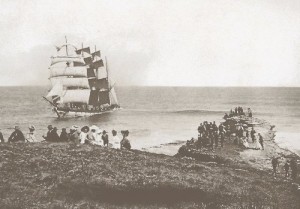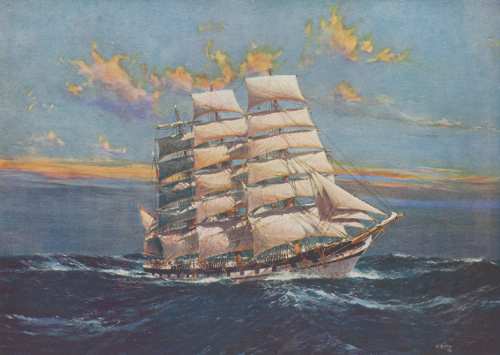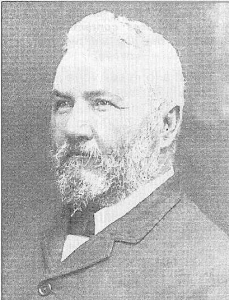Two mutinies, a man presumably lost overboard, two women crew members and a wreck off the coast of Australia are just some of the colourful incidents in the life of this four-masted, iron-hulled barque which was painted in 1927 by marine artist Jack Spurling.
The painting by Spurling, while spirited, gives little indication of the rather dramatic life of the ship itself, which started at Greenock on the river Clyde in Scotland in 1886, where she was built for the Falls Line of Glasgow by shipbuilders Russell and Company.
The ship was just over 2000 gross tons and had a length of 83.87 metres, a beam of 12.64 metres and a draught of 7.23 metres. Her hull was of iron and her masts and rigging of steel instead of the more usual wooden spars and hemp ropes. Another innovation included in her design was the provision of “bridges” which allowed the sailors to move in relative safety even in rough weather when seas would regularly break over the decks.
The Falls of Halladale was built to carry general cargo, a highly competitive and rather rough trade in those days.
In 1896 under the command of a seasoned sailing ship skipper Captain William Fordyce from Lerwick in Shetland made a record-breaking run from Swansea in Wales to San Francisco in California, taking only 39 days from Cape Horn to her destination, which was,
as reported by the San Francisco Call of 24 January 1896, “equal to steamer time.”
On that same trip a seaman, Charles Anderson, reported for duty when the ship sailed, but was somewhat inebriated and on the first watch call the next day was missing. It was presumed that he had during the night gone up to the forecastle and been washed overboard.
In March 1899 the Falls of Halladale sailed from Tacoma in Washington State bound for Cape Town and the crew mutinied, claiming they had been “Shanghaied” but after about five hours the men went to work and the ship was under sail for South Africa.
On route to South Africa more incidents occurred – first the mate was washed into the scuppers by a large wave and suffered a broken collar-bone and a dislocated shoulder; then four of the crew became ill.
The ship sailed from Hamburg, Germany, in June 1900 with the two women in the crew. They were Capt Fordyce’s wife, who was 58 at the time, and her daughter Jeanie who was at the time in her 20s. They were signed on as “Purser” and “Assistant Purser” with wages of one shilling a month. They apparently spent much of the two years they were aboard the ship doing needlework!
On 25 July 1903 the ship, now under the command of Captain D.W. Thomson, sailed from Liverpool with a cargo of pig iron, salt, soda and some general merchandise, according to the San Francisco Call of 14 March 1904. The ship ran into rough weather in September 1903 off the islands of Diego Ramirez south west of the notorious Cape Horn. The weather continued foul for three weeks and they struggled to round the Cape.
At last in January 1904 they made land at Invercargil in New Zealand by which time the crew was becoming mutinous. Eight crew members, under the leadership of on Thomas Mooney, had to be put in irons and, after the ship had received fresh water and supplies from the shore, anchor was weighed and they set sail once more for San Francisco.
To the newspaper Capt Thomson said of this experience: “I have been going to sea for a great many years and this was one of the most tempestuous voyages I have ever experienced. The storms off Cape Horn were of terrible violence and for three weeks we were almost practically at the mercy of the terrible succession of hurricanes we ran into. Of course the vessel must have suffered from the terrific strain she was labouring under, and from the terrible seas that kept pounding on her decks. It is impossible for me to state anything about the cargo, but naturally it must be more or less in a damaged condition. We have a quantity of salt in sacks on board and this, of course, has suffered. The soda must also be damaged. The experience at Invercargil was a bitter one, and it was a hard fight for me to keen the crew in order.”

People from the nearby town of Peterborough came out to see the wreck of the Falls of Halladale. Image via Wikipedia.
Unfortunately for Capt Thomson an even more bitter experience was to befall him two years later. On 14 November 1908 Thomson, on a voyage from New York to Melbourne, Australia, estimated he was safely off the coast of Victoria but could not verify his position due to heavy fog. By the time the fog lifted he could see he was much too close inshore but it was too late to do anything about it and the ship ran onto the rocks under full sail.
All 29 crew members were able to get ashore, but there was no hope of salvaging the cargo and the ship sat on the rocks with all sails still set, becoming a sight for the residents of near-by Peterborough. They would come out to picnic on the hills above the wreck, which has since been declared a historic wreck site.
Capt Thomson was charged by a Court of Marine Inquiry in Melbourne which found him guilty of gross misconduct and imposed a small fine and suspended his master’s ticket for six months.
A sad end indeed for a colourful ship.
The painting is in oils on canvas laid on board and measures 86.4 cm. x 106.7 cm.



Speak Your Mind